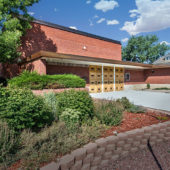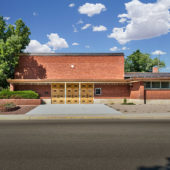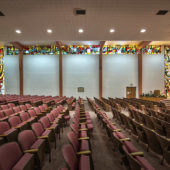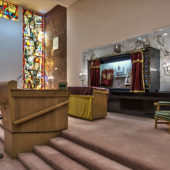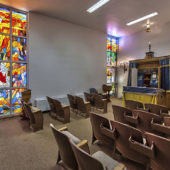Wyoming’s oldest and largest Jewish congregation.
According to the 2010 Religious Census, Wyoming is the -least Jewish state in America- with only 2/100ths of 1 percent of its population identifying themselves as adhering to the Jewish religion. That’s about 1/4th of the national average. The State’s small Jewish Community is active and flourishing.
Mt. Sinai Congregation is the oldest and largest Jewish congregation in the state. Its first permanent synagogue building was erected in 1915. The following information is quoted directly from Mt. Sinai’s website:
History of the Congregation
Cheyenne became a town when the railroad reached it in 1869. It had been a construction site from 1867. Among the first settlers there were two Jewish men, William Myers and Max Idelman, emigrants from Germany seeking religious freedom. By 1888 there were enough Jewish families to incorporate Temple Emanuel, and student Rabbis from a Cincinnati Seminary were brought to Wyoming to lead services during the High Holy Days.
During the early years of the 20th century immigration from Eastern Europe, mainly Russia, Poland, Hungary, and Czechoslovakia began to settle in America. Some came to Wyoming because of free land offered with the Homestead Act. Some came west seeking more opportunities. This wave of immigration was mostly Orthodox in their beliefs, and in 1910 Mt. Sinai was incorporated in a small house on Eddie Street (now Pioneer and 20th) and built the first synagogue, setting the cornerstone on October 24th, 1915. Another migration came after the Second World War and the Holocaust.
As the old building was outdated and inadequate for the increasing congregation, the late H.R. Cohen, Dave Wolfe, Herman Pasternack, and Sam Stark purchased a lot on the corner of 26th and Pioneer, where the current synagogue was built. Mr. Cohen headed the building committee and the contractor was Carl Christiansen; a new cornerstone was laid in the Spring of 1950. The building was dedicated in 1951 including a sanctuary seating 450, a small sanctuary for daily prayer to accommodate 30, a social hall for dinners; a full kosher kitchen facility, several classrooms, and a Rabbi study. An adjoining lot was added for a grassed area for picnics and social events.
The main sanctuary features stained glass windows, the largest one of fifteen panes has a candelabra twelve feet high, a menorah, dedicated in December 1972. Also on the southern wall are twenty windows depicting highlights in Biblical history and a bank of twelve windows of the twelve tribes of the Bible adjacent to the altar. As the sun illuminates the various colors of the stained glass it is breathtaking in its beauty. This project, conceptualized by the late George Kaufman and John Veta, was used as a fundraising tool to finish some of the building costs. All of the windows were created and installed by the members of the Watkins Family Stained Glass Studios of Denver. The opposite wall in the sanctuary has twenty windows depicting the major Jewish holidays and was dedicated in 1977. All windows with one exception were purchased by members of the congregation in honor or memory of family. The one exception, a picture of modern Jerusalem, was dedicated to a non-Jewish doctor of Scotch descent, K.L. McShane, a long-time friend of the Jewish Community. It is on the left of the north side windows.
A unique feature of the synagogue was first viewed as a disaster when the contractor discovered a stream running through the property. Now that stream enables the synagogue to have a highly valued ritual bath of -living- water in its partial basement.
The building includes a library of Jewish books, tapes and periodicals, currently chaired by Dorothy Feldman in memory of her late husband, Joe Feldman. His extensive collection of books has been doubled by donations of many people who lived in Cheyenne and left their treasured books to the library upon their death.
Jewish settlement in Wyoming has been called the furthermost reaches of the Jewish Diaspora since it represented settlement far removed from the limitations that had been placed on Judaism in Germany and Russia. Jewish participation in the life of Cheyenne and Wyoming has made the slogan -The Equality State- more meaningful.

